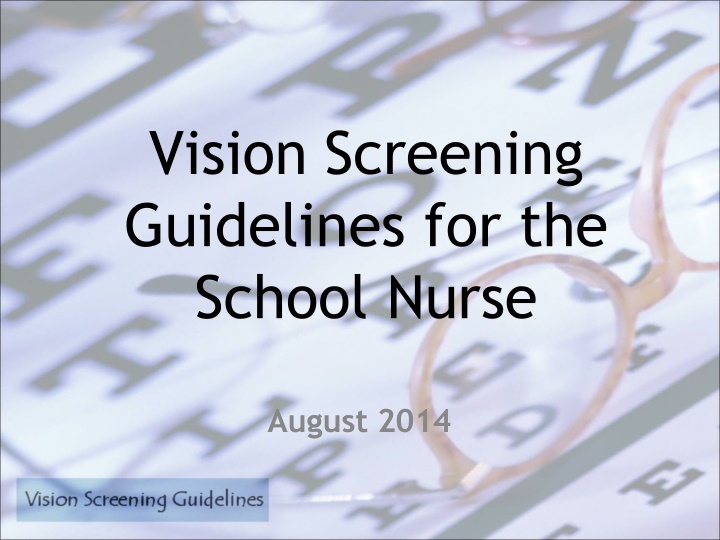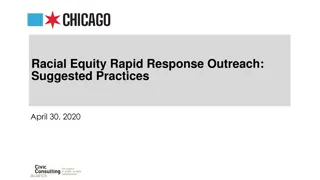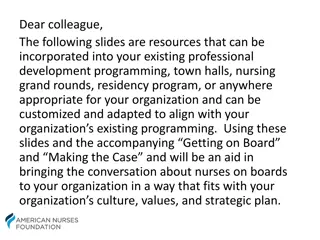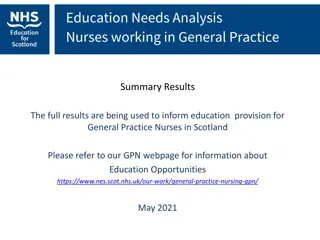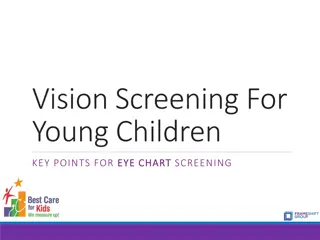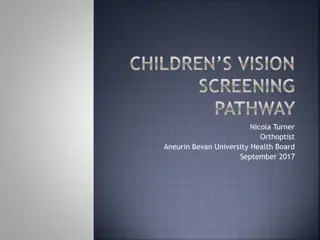Vision Screening Guidelines for School Nurses: A Comprehensive Overview
Detailed guidelines for school nurses on vision screening, including the purpose, recommended procedures, follow-up processes, and evaluation criteria. Covers the importance of early intervention, referral protocols, and parental involvement in the screening program. Provides insights on the characteristics of screening programs and emphasizes the need for meticulous evaluation to ensure effectiveness.
Download Presentation

Please find below an Image/Link to download the presentation.
The content on the website is provided AS IS for your information and personal use only. It may not be sold, licensed, or shared on other websites without obtaining consent from the author.If you encounter any issues during the download, it is possible that the publisher has removed the file from their server.
You are allowed to download the files provided on this website for personal or commercial use, subject to the condition that they are used lawfully. All files are the property of their respective owners.
The content on the website is provided AS IS for your information and personal use only. It may not be sold, licensed, or shared on other websites without obtaining consent from the author.
E N D
Presentation Transcript
Vision Screening Guidelines for the School Nurse August 2014
Objectives Discuss the purpose and evaluation of any screening program State the purpose of vision screening in the school Identify the recommended vision screening procedures and equipment Explain the importance of follow up and tracking of vision referrals
Purpose of A Screening Program To identify or detect . 1. Commonly occurring diseases/entities/health problems or conditions in order to facilitate 2. Early intervention that will be 3. Significantly beneficial to the client Proctor, 2005
Characteristics of Screening Programs Brief or limited evaluation of a group of individuals presumed to be normal Results must be communicated Follow-up on referrals for those atrisk key component of screening Follow-up continued until problem is resolved
Referral Process Parents Notify by phone/visit any student who meets the referral criteria following the screening and the rescreening Parental understanding Elicit need for additional resources/assistance Provide information on community resources
Referral Results Follow with written referral communicating results of the screening Request written report with results/recommendations Contact parent periodically and provide assistance as needed Track referrals made Notify classroom teacher
Evaluation of Screening Program To determine the effectiveness of any screening program, careful evaluation of the planning, implementation, referral process, and referral outcomes must be completed with each screening.
Evaluation Evaluate in terms of: Validity ability to identify those who have condition Reliability consistency of results Yield number of persons identified Cost personnel and equipment Acceptance informed parents agree to value Follow up communicating results to parents who respond with appropriate actions to get necessary diagnosis and treatment if indicated
Vision Screening Guidelines
Purpose and Objective of A Vision Screening Program Ability to see impacts on student s ability to learn Estimated 80% of learning occurs through visual senses Influences student s performance and adjustment in school, society, as well as overall health and behavior
Purpose and Objective of A Vision Screening Program Identify children with possible visual defects at earliest possible stage allowing time to refer for diagnosis and treatment Earlier identification results in improved outcomes
Screening Program Schedule Type of Screening Grade Screen All students new to district K Recommended Age Appropriate Near & Distance Acuity, Random Dot E Recommended Near & Distance Acuity, Random Dot E 1st Recommended Near & Distance Acuity, Random Dot E 2nd Recommended Near & Distance Acuity, Random Dot E 3rd Recommended Every other year after 3rd grade Recommended as time permits Near & Distance Acuity
Visual Acuity Visual acuity refers to the sharpness of one s eyesight. Acuity is reported in a fraction. Numerator distance from the subject to the chart Denominator size of the symbol the person can see at 20 feet Example 20/40, at 20 feet the eye sees at a 20 foot distance what a normal eye sees at 40 feet
Childhood Vision Disorders Condition Myopia Negative Impact Blurry distance vision Poor school performance Intervention Glasses Contact Lenses Blurry near vision Eye strain Difficulty reading Poor school performance Blur at distance and near Eye strain Glasses Contact Lenses Hyperopia Glasses Contact Lenses Astigmatism
Myopia The most common of the refractive errors. Formerly called nearsightedness . Unable to see clearly at distance.
Hyperopia A refractive error in which the light rays from an incoming visual image have not converged by the time they reach the retina. Formerly called farsightedness . Near vision is blurry.
Strabismus A manifest deviation of one or both eyes from the visual axis of the other so they are not simultaneously directed to the same object. Also referred to as heterotropia, or tropia.
Amblyopia An ocular condition in an otherwise healthy eye, in which there is an abnormality of corticol response in the occipital lobe of the brain due to insufficient or inadequate stimulation of the fovea, neural pathway, and cortex that may result in unilateral vision loss if untreated.
Amblyopia Good eye Amblyopic eye
Distance Visual Acuity Screening Purpose Screen for clearness of vision when looking in the distance Detect Myopia (nearsightedness) Amblyopia (weakness of sight, lazy eye) Astigmatism (blurred vision)
Distance Visual Acuity Screening Equipment Distance chart for 10 or 20 feet (should include 20/25 line) Choose according to student s developmental level HOTV, Snellen, Sloan, Tumbling E, LEA Symbol, Lighthouse Occluder (e.g., paper cup, paper patch, palm of hand with tissue) Antibacterial wipes
Examples of Vision Charts
Distance Visual Acuity Screening Location Quiet with no distractions Well lit and free from glare Suggestions o Room 5 feet longer than distance for screening tool o Minimum of 8-10 feet between stations if multiple stations
Distance Visual Acuity Screening Setup Chart at student s eye level o May be seated or standing Mark off a 10-20 feet distance with tape o Position heels or back legs of chair on tape o Eyes should be in direct line above tape
Distance Visual Acuity Screening Procedure Orient student to the screening Demonstrate use of occluder Ask if student wears glasses. If yes, screening should be done with glasses on (be sure to mark the form) Watch carefully that student is not peeking, tilting head, squinting or leaning head or torso forward Begin by screening right eye with left eye occluded Instruct to keep both eyes open and read the selected letter or line of letters with the uncovered eye. Begin at 20/50 line and move down to 20/20 line
Distance Visual Acuity Screening (cont.) Procedure (cont.) Move upward if student unable to read 20/50 line Do not use marking device as pointer to avoid leaving distracting marks on chart Student must identify or match one more than half of the letters/symbols on a line Record results including the line number for the last line read correctly with each eye Repeat procedure for left eye If student is unsuccessful, he or she should be rescreened within 14-21 days
Distance Visual Acuity Referral Criteria A failed screening followed by a failed rescreening should be referred for further evaluation Grade Criteria Each eye must see at least the 20/40 line. Kindergarten Each eye must see at least the 20/30 line. 1st 12th grade
Distance Visual Acuity Referral Criteria Important Exception Refer if there is a two-line difference One Eye Other Eye Results 20/20 20/20 Pass 20/25 20/25 Pass 20/30 20/30 Pass 20/20 20/25 Pass Refer 2 line difference 20/20 20/30
Near Visual Acuity Screening Purpose Screen for near visual acuity Detect excessive hyperopia (farsightedness) Equipment Near vision chart chosen according to student s developmental level (should include 20/25 line) Occluder (e.g., paper cup, paper patch, palm of hand with tissue) Antibacterial wipes
Near Visual Acuity Screening Location Quiet and no distractions Well lit and free from glare Suggest--minimum of 8-10 between stations if multiple stations
Near Visual Acuity Screening Procedure Orient student to the screening Demonstrate use of occluder Ask if student wears glasses. If yes, screening should be done with glasses on (be sure to mark the form) Watch carefully that student is not peeking, tilting head, squinting or leaning head or torso forward
Near Visual Acuity Screening Procedure (cont.) Begin by screening right eye with left eye occluded Instruct to keep both eyes open and read the selected letter or line of letters with the uncovered eye. Begin at 20/50 line and move down to 20/20 line Ask the student to name or read the letter or symbols on each line as directed.
Near Visual Acuity Screening Procedure (cont.) Move upward if student unable to read 20/50 line Do not use marking device as pointer to avoid leaving distracting marks on chart Student must identify or match one more than half of the letters/symbols on a line
Near Visual Acuity Procedure (cont.) Record results including the line number for the last line read correctly with each eye Repeat procedure for left eye If student is unsuccessful, he or she should be rescreened within 14-21 days
Near Visual Acuity Referral Criteria A failed screening followed by a failed rescreening should be referred for further evaluation Grade Criteria Each eye must see at least the 20/40 line. Kindergarten Each eye must see at least the 20/30 line. 1st 12th grade
Near Visual Acuity Referral Criteria Important Exception Refer if there is a two-line difference One Eye Other Eye Results 20/20 20/20 Pass 20/25 20/25 Pass 20/30 20/30 Pass 20/20 20/25 Pass Refer 2 line difference 20/20 20/30
Binocularity/Stereoscopic Vision Screening What is Binocular Vision Includes ocular alignment and stereo acuity Screening determines how well eyes function together
Binocularity/Stereoscopic Vision Screening Purpose of Screening to determine if student has adequate binocularity Equipment Random Dot (RDE) Stereotest Kit Antibacterial wipes
Random Dot E Kit Equipment
Random Dot E Constructed of cardboard with a large raised, embossed E Used only for training purposes as it is easy for the student to see Model E Slide
Random Dot E Presents an array of dots that appear to be randomly oriented. When viewed through polarized glasses, an E appears in the test plate if the student has normal binocular vision. Used for screening purposes only Raised/Recessed E Slide
Random Dot E With the glasses in place, children with good alignment and normal binocular vision will be able to see the stereo E in 3-dimensions.
Random Dot E Presents a random array of dots. No E appears even with the polarized glasses in place. Used for training purposes Stereo Blank Slide
Random Dot E Is also used for screening purposes when paired with the Raised/Recessed E Slide Stereo Blank Slide
Random Dot E Location and Setup Make sure that the test distance between the student and the cards is carefully measured at 40 inches. Make sure that there is bright room lighting.
Random Dot E Procedure Have student put on stereo glasses. If the student wears glasses, the stereo glasses should be placed over the student s own glasses. (Indicate on form) Be sure the student keeps head straight when viewing slides
Random Dot E Hold model E demonstration plate at a distance of a 40 inches in front of student.
Random Dot E Point to the E and say to the student, Tell me what you see.
Random Dot E Pick up the blank test plate and hold it next to the demonstration plate. Ask the student to point to the plate with the raised, embossed E .
